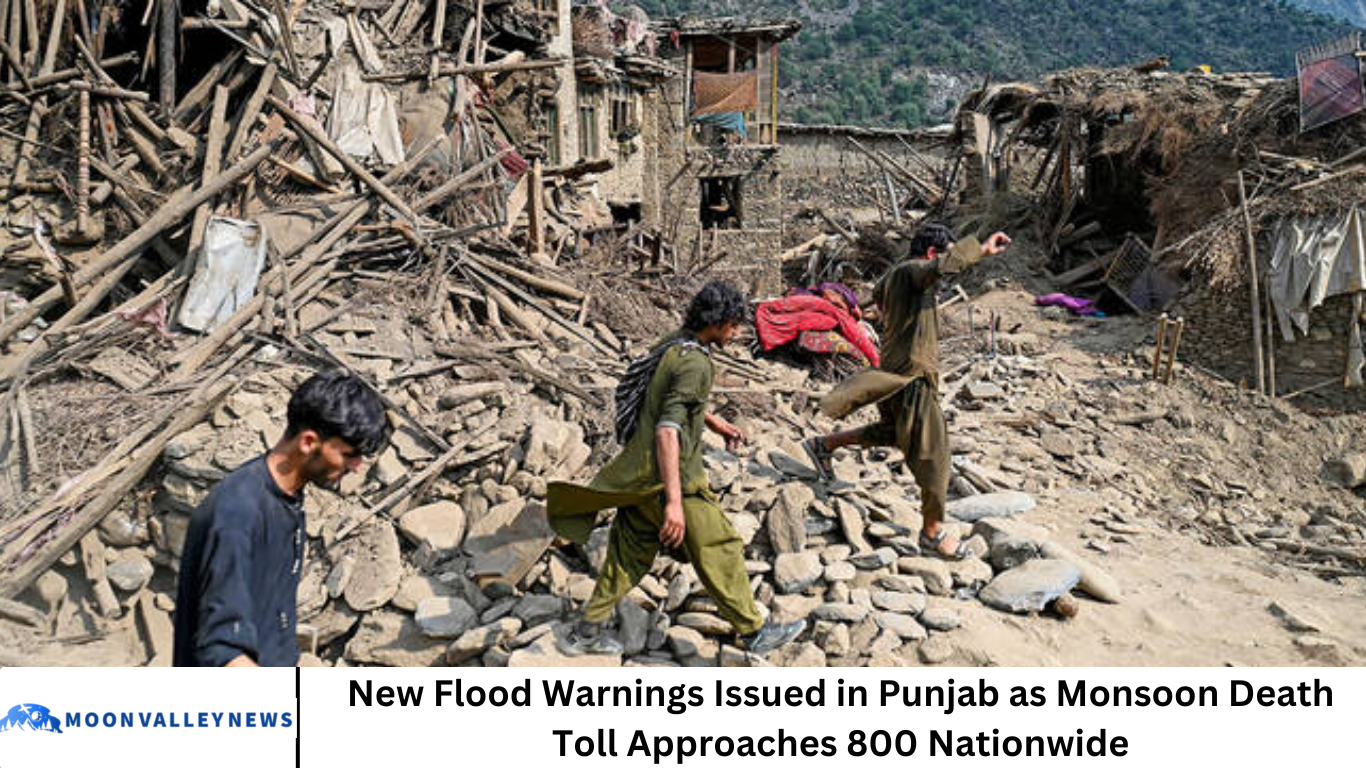ISLAMABAD – The 2025 monsoon season continues to wreak havoc across Pakistan as fresh flood warnings were issued on Monday in Punjab, the country’s most populous province. With the nationwide death toll nearing 800, disaster management authorities have sounded the alarm, warning of potentially catastrophic flooding in rivers, urban centers, and mountainous areas.
As climate change continues to fuel unpredictable and extreme weather patterns, Pakistan finds itself once again battling widespread devastation during what should be a routine monsoon. The latest alerts from the Punjab Provincial Disaster Management Authority (PDMA) signal growing concerns about the scale of destruction, urging authorities and citizens to brace for more heavy rain and flooding over the coming days.
Rising Monsoon Toll: Nearly 800 Lives Lost
Since the onset of the monsoon season in late June, the National Disaster Management Authority (NDMA) has confirmed at least 799 deaths nationwide due to rain-related incidents including floods, landslides, building collapses, and electrocution. Of these, an alarming 485 deaths occurred in just the past 10 days, highlighting the severity of the current weather system.
The NDMA has warned that this year’s monsoon season, expected to last until at least September 10, may match or even surpass the devastation seen during the historic 2022 floods, which killed more than 1,700 people and caused over $30 billion in damages.
Punjab Faces Severe Flood Risk: PDMA Alerts
According to the PDMA, there is a high to very high risk of flooding in several major rivers of Punjab, including:
- Chenab River
- Ravi River
- Sutlej River
These rivers, swollen by continuous rain and upstream water inflows from India, may overflow their banks within 48 hours, putting dozens of low-lying districts at imminent risk.
Urban flooding is also expected in major metropolitan areas such as:
- Lahore
- Rawalpindi
- Gujranwala
Additionally, flash floods are predicted in the northern and northeastern districts of Punjab, including Murree, Chakwal, and Jhelum, where hilly terrain and rapid water runoff increase the risk of landslides and road blockages.
Emergency Response Measures Activated
In response to the escalating crisis, PDMA Director-General Irfan Ali Kathia issued directives to local governments:
“Deploy rescue teams in advance at sensitive locations to deal with the emergency situation,” Kathia instructed in an official notice sent to commissioners and deputy commissioners.
He further emphasized the importance of community-level awareness:
“In case of heavy rain, inform the citizens in advance. Announcements should be made in mosques and instructions should be issued to the citizens at the local level to stay in safe places.”
The provincial administration has been urged to activate emergency flood response centers, coordinate with the Pakistan Army and Rescue 1122, and ensure that evacuation plans are in place.
Mountain Streams and Nullahs Overflowing
The PDMA has also issued warnings about medium to high water flows in small rivers and nullahs originating from the Pir Panjal mountain range. Key streams at risk include:
- Bein Nullah
- Basantar Nullah
- Deg Nullah
The area around Jassar, near the Indian border, is expected to witness low to medium flooding within the next 24 hours, further complicating emergency efforts in an already saturated terrain.
NDMA Guidelines for Citizens in Flood-Prone Areas
The NDMA has issued comprehensive safety advisories for people living in flood-prone and low-lying areas:
- Remain alert and listen to local news and official bulletins.
- Avoid unnecessary travel near rivers, canals, and hilly terrain.
- Prepare emergency kits with at least 5 days’ supply of food, water, medicines, flashlights, and batteries.
- Secure important documents in waterproof containers.
- Relocate livestock to higher ground.
- Do not cross causeways, low bridges, or flooded roads.
These precautions are designed to minimize casualties and losses, especially in rural communities with limited infrastructure and delayed access to emergency services.
Punjab’s Eighth Monsoon Spell in Full Force
According to the Pakistan Meteorological Department (PMD), Punjab is currently experiencing its eighth monsoon spell, which began in mid-August and is projected to last until August 27. The upper Punjab region, which includes:
- Murree
- Rawalpindi
- Attock
- Jhelum
- Chakwal
is expected to receive the heaviest downpours, increasing the risk of landslides, flash floods, and waterlogging.
The continued rainfall not only hampers rescue and relief efforts but also weakens the soil structure, increasing the chances of structural collapses and agricultural losses.
Economic Impact of Monsoon Flooding
While the human toll is the most immediate concern, the economic fallout of the flooding is already being felt.
Key sectors affected:
- Agriculture: Punjab, known as the breadbasket of Pakistan, faces significant losses in rice, maize, cotton, and sugarcane crops due to waterlogging and soil erosion.
- Infrastructure: Roads, bridges, and railways have been damaged or rendered inaccessible in many districts.
- Livelihoods: Farmers, daily wage workers, and small traders are among the hardest hit, losing their income sources for weeks or months.
Experts warn that the cumulative losses could run into hundreds of millions of dollars, compounding the country’s ongoing economic crisis and inflationary pressures.
Climate Change: The Growing Threat Behind Monsoon Chaos
Pakistan ranks among the top 10 countries most vulnerable to climate change, despite contributing less than 1% to global greenhouse gas emissions. The intensification of the monsoon season, including the frequency and severity of flooding, is being linked directly to climate-induced changes in weather patterns.
Rising global temperatures are causing:
- Increased glacial melting, leading to more water entering river systems.
- Unpredictable rainfall patterns, with intense cloudbursts in short durations.
- Longer and more volatile monsoon seasons.
Environmentalists argue that unless urgent climate adaptation and mitigation measures are implemented, events like the 2025 floods will become more frequent and more deadly.
Lessons from 2022: Are We Better Prepared?
The 2022 floods were a turning point in Pakistan’s climate narrative, prompting international appeals for aid and a push toward long-term solutions. However, three years on, the resilience of local infrastructure, urban planning, and disaster preparedness remains underwhelming.
Critics point out:
- Poor drainage systems in cities like Lahore and Karachi.
- Lack of early warning systems in remote areas.
- Minimal investment in flood-resistant housing and infrastructure.
- Insufficient public awareness campaigns on climate safety.
While progress has been made in setting up national climate financing frameworks and seeking international support, implementation at the local level is lagging.
Government and International Response
The Federal Government, along with provincial administrations, has begun mobilizing funds, relief supplies, and personnel, with a focus on rescue, relief, and rehabilitation.
Prime Minister and Chief Ministers have visited affected areas and pledged support, but bureaucratic delays and coordination challenges have hampered swift action.
Meanwhile, international humanitarian agencies, including the UN, Red Crescent, and INGOs, have begun assessments and pre-positioning aid in flood-prone districts.
A Call to Action: Building Climate Resilience
As the country grapples with the current crisis, experts emphasize the need to focus on long-term climate resilience. Some key recommendations include:
- Investing in early warning systems and real-time satellite monitoring.
- Upgrading urban infrastructure to handle extreme weather events.
- Building embankments and flood diversion channels in high-risk zones.
- Educating communities on climate safety and disaster preparedness.
- Incorporating climate risk assessments into all development planning.
Pakistan’s survival in an increasingly hostile climate environment depends on how quickly and effectively it adapts to these new realities.
Frequently Asked Question
What areas in Punjab are most at risk due to the new flood warnings?
The most affected areas include low-lying districts near the Chenab, Ravi, and Sutlej rivers. Urban flooding is expected in major cities such as Lahore, Rawalpindi, and Gujranwala, while flash floods are likely in the northern and northeastern regions, including Murree, Jhelum, and Chakwal.
Why are floods so severe during this year’s monsoon season?
This year’s monsoon is particularly severe due to climate change-driven weather patterns, heavier than average rainfall, glacial meltwater from the north, and poor drainage infrastructure in urban areas. Additionally, back-to-back monsoon spells without recovery time have worsened flood risks.
How many people have died during the 2025 monsoon season in Pakistan so far?
As of the latest update, at least 799 people have died due to rain-related incidents, including floods, landslides, building collapses, and electrocution. The death toll has risen sharply in the past 10 days, with 485 deaths reported during this period alone.
What is the government doing to manage the flood crisis in Punjab?
The Punjab Provincial Disaster Management Authority (PDMA) has deployed rescue teams, issued alerts to local administrations, and coordinated evacuation plans. The National Disaster Management Authority (NDMA) is providing guidelines, mobilizing resources, and collaborating with federal and provincial bodies for response and relief.
How long is the monsoon season expected to last in Pakistan this year?
According to the Pakistan Meteorological Department (PMD) and NDMA, the monsoon season is expected to continue until at least September 10, 2025. Additional rain spells are forecast, especially in upper Punjab and northern regions.
What precautions should residents in flood-prone areas take?
Residents are advised to:
- Stay updated via official alerts and weather forecasts.
- Prepare emergency kits with food, water, medicines, and important documents.
- Move to higher ground if advised.
- Avoid crossing flooded roads or bridges.
- Secure livestock and valuables in safe locations.
Could this monsoon season be as devastating as the 2022 floods?
Yes, authorities warn that the 2025 monsoon season could potentially rival the scale of the 2022 floods, which killed over 1,700 people and caused over $30 billion in damages. Experts stress the importance of climate adaptation and better disaster preparedness to prevent a repeat of such a catastrophe.
Conclusion
The issuance of new flood warnings in Punjab and the steadily rising monsoon death toll, now approaching 800 nationwide, paints a grim picture for Pakistan during the 2025 monsoon season. While immediate rescue efforts are critical, this crisis underscores a deeper need for climate resilience, governance reform, and community engagement. If Pakistan is to prevent future tragedies of this scale, it must treat this moment not only as a disaster but also as a turning point — a call to build a safer, more sustainable, and climate-resilient future for all.





